Analysis of International Hospitality Management for IHG Group
VerifiedAdded on 2020/02/24
|25
|5906
|471
Report
AI Summary
This report provides a comprehensive analysis of international hospitality management, focusing on the InterContinental Hotels Group (IHG Group), particularly its Crowne Plaza brand. The report begins with an introduction to the tourism industry's global economic impact, highlighting trends in business versus leisure travel and domestic versus international spending. It then provides background on IHG Group and Crowne Plaza, emphasizing their strategies for adapting to changing market dynamics and customer needs. The report delves into global hospitality markets, discussing market segmentation, the importance of quality, and the impact of technology and emerging markets. A detailed market analysis is conducted, including PESTLE and Porter's Five Forces analyses, SWOT analysis, and a discussion of market growth strategies such as Porter's Generic Strategy and the Ansoff Matrix. The report focuses on the Indian market as a case study, examining its potential as a successful travel destination. The report concludes with recommendations for IHG Group's international hospitality management, supporting the need to expand in emerging markets.
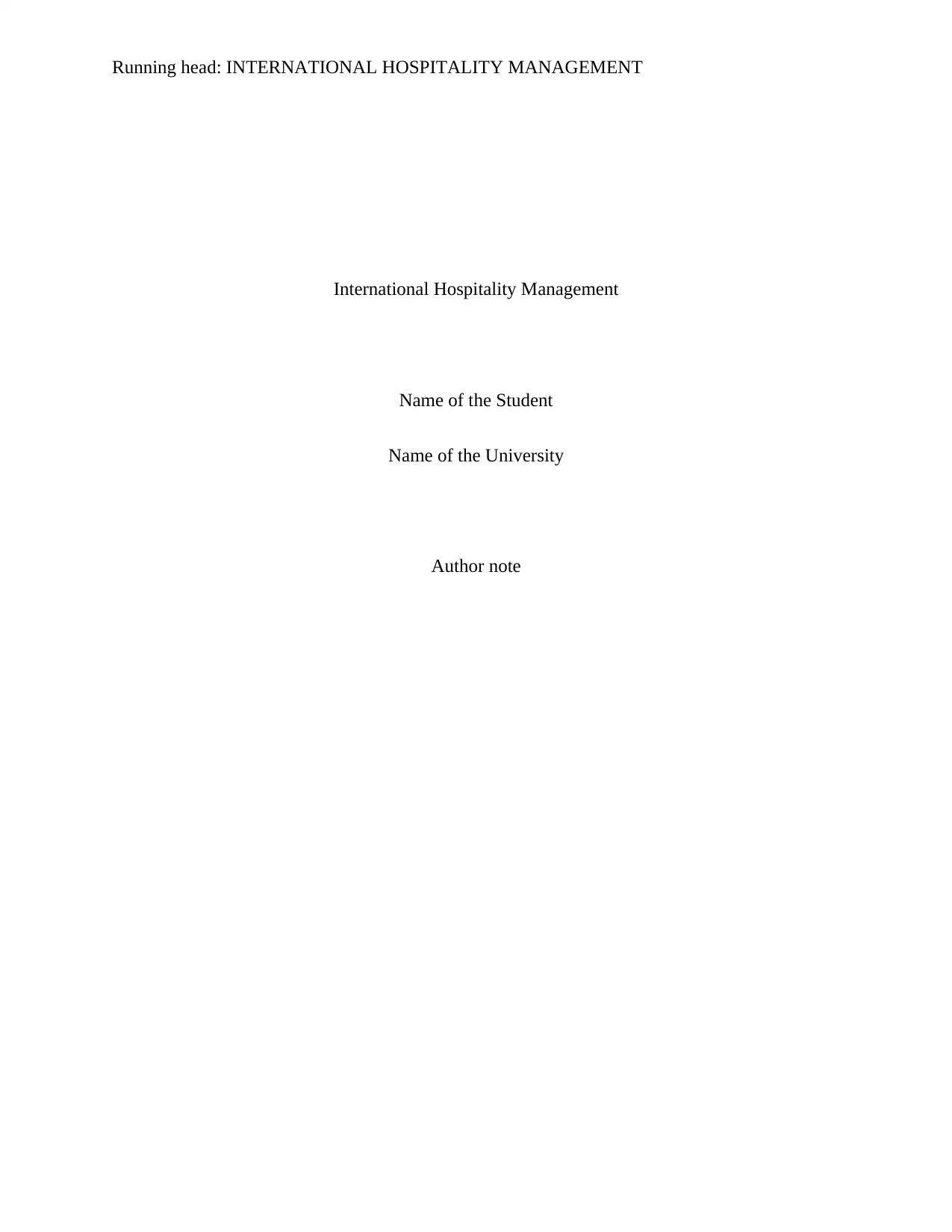
Running head: INTERNATIONAL HOSPITALITY MANAGEMENT
International Hospitality Management
Name of the Student
Name of the University
Author note
International Hospitality Management
Name of the Student
Name of the University
Author note
Paraphrase This Document
Need a fresh take? Get an instant paraphrase of this document with our AI Paraphraser
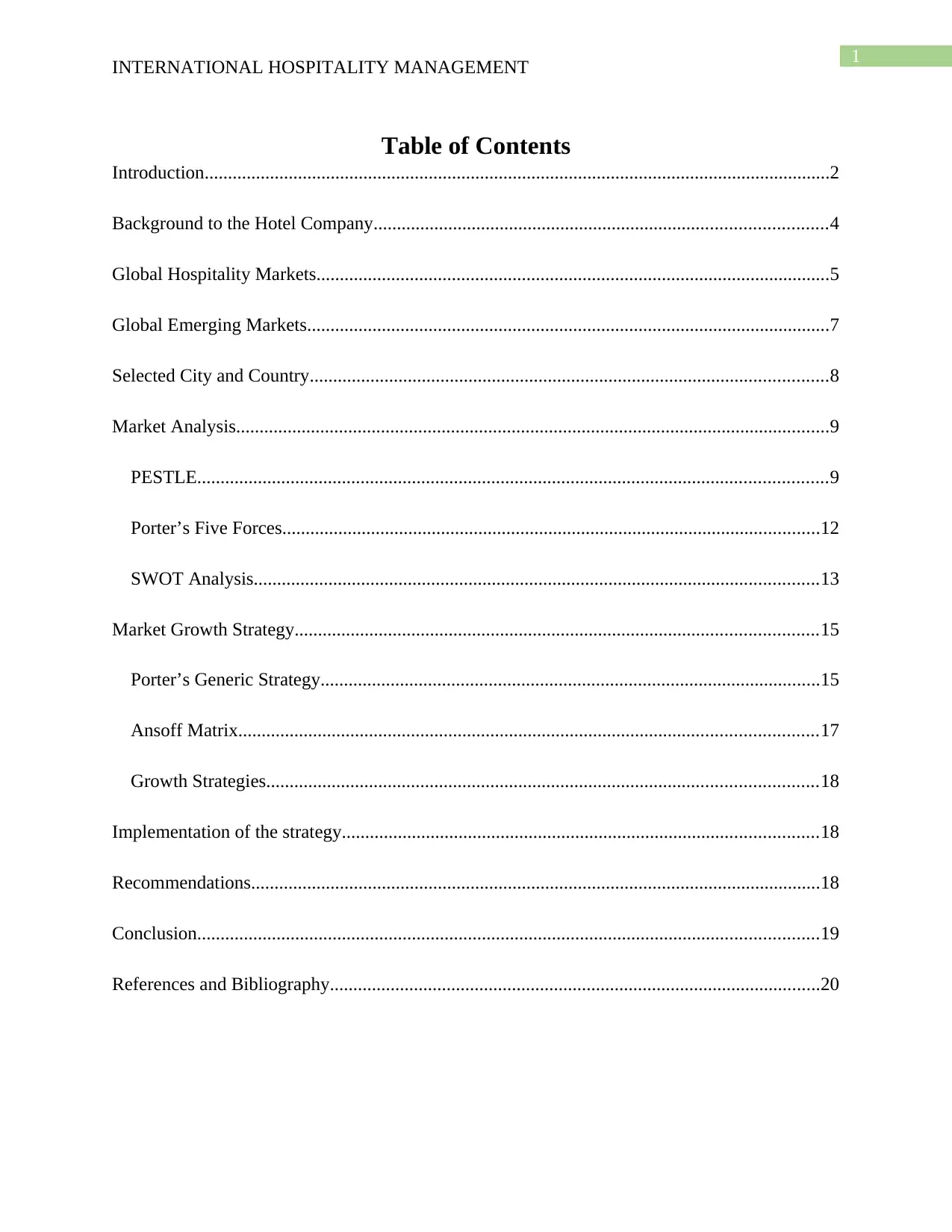
1
INTERNATIONAL HOSPITALITY MANAGEMENT
Table of Contents
Introduction......................................................................................................................................2
Background to the Hotel Company.................................................................................................4
Global Hospitality Markets..............................................................................................................5
Global Emerging Markets................................................................................................................7
Selected City and Country...............................................................................................................8
Market Analysis...............................................................................................................................9
PESTLE.......................................................................................................................................9
Porter’s Five Forces...................................................................................................................12
SWOT Analysis.........................................................................................................................13
Market Growth Strategy................................................................................................................15
Porter’s Generic Strategy...........................................................................................................15
Ansoff Matrix............................................................................................................................17
Growth Strategies......................................................................................................................18
Implementation of the strategy......................................................................................................18
Recommendations..........................................................................................................................18
Conclusion.....................................................................................................................................19
References and Bibliography.........................................................................................................20
INTERNATIONAL HOSPITALITY MANAGEMENT
Table of Contents
Introduction......................................................................................................................................2
Background to the Hotel Company.................................................................................................4
Global Hospitality Markets..............................................................................................................5
Global Emerging Markets................................................................................................................7
Selected City and Country...............................................................................................................8
Market Analysis...............................................................................................................................9
PESTLE.......................................................................................................................................9
Porter’s Five Forces...................................................................................................................12
SWOT Analysis.........................................................................................................................13
Market Growth Strategy................................................................................................................15
Porter’s Generic Strategy...........................................................................................................15
Ansoff Matrix............................................................................................................................17
Growth Strategies......................................................................................................................18
Implementation of the strategy......................................................................................................18
Recommendations..........................................................................................................................18
Conclusion.....................................................................................................................................19
References and Bibliography.........................................................................................................20
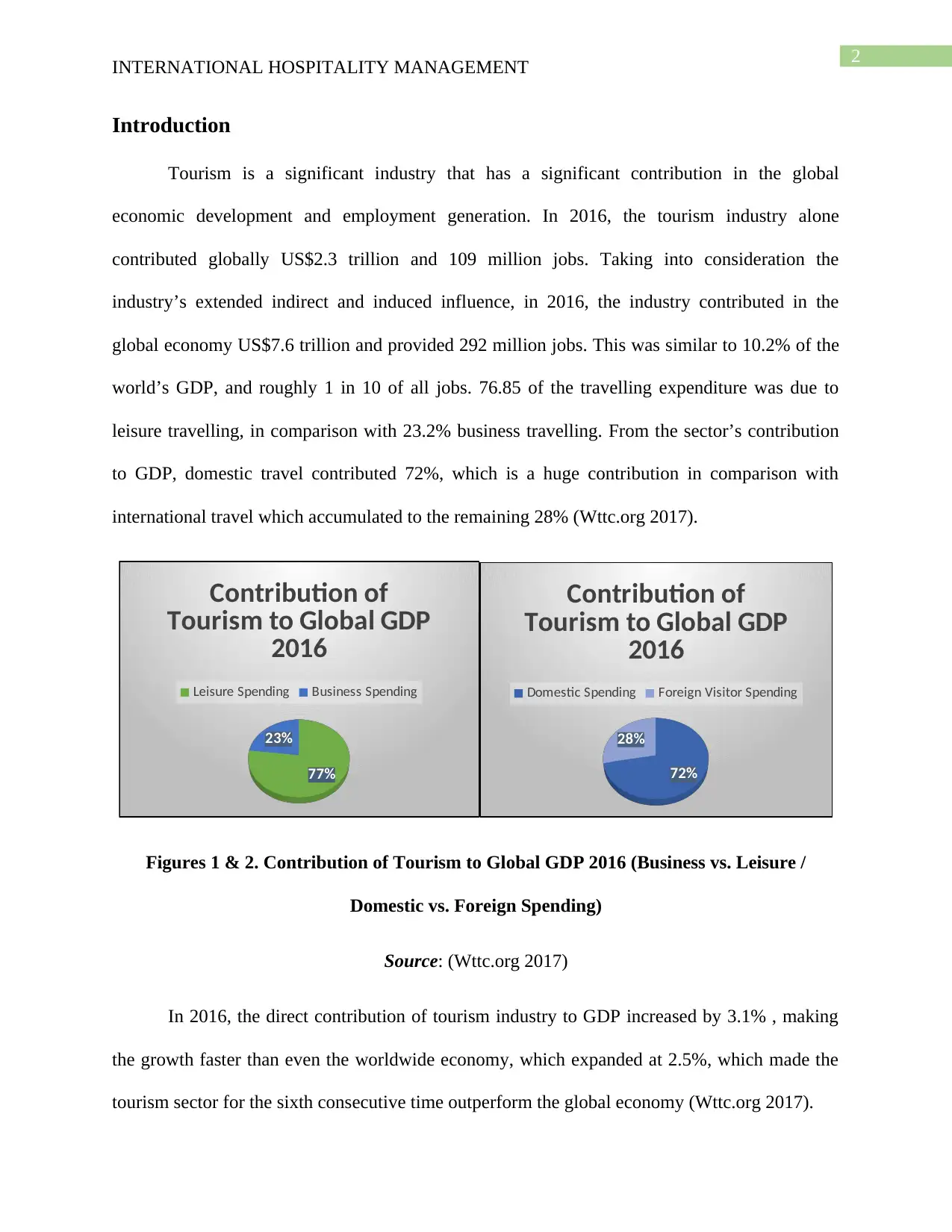
2
INTERNATIONAL HOSPITALITY MANAGEMENT
Introduction
Tourism is a significant industry that has a significant contribution in the global
economic development and employment generation. In 2016, the tourism industry alone
contributed globally US$2.3 trillion and 109 million jobs. Taking into consideration the
industry’s extended indirect and induced influence, in 2016, the industry contributed in the
global economy US$7.6 trillion and provided 292 million jobs. This was similar to 10.2% of the
world’s GDP, and roughly 1 in 10 of all jobs. 76.85 of the travelling expenditure was due to
leisure travelling, in comparison with 23.2% business travelling. From the sector’s contribution
to GDP, domestic travel contributed 72%, which is a huge contribution in comparison with
international travel which accumulated to the remaining 28% (Wttc.org 2017).
77%
23%
Contribution of
Tourism to Global GDP
2016
Leisure Spending Business Spending
72%
28%
Contribution of
Tourism to Global GDP
2016
Domestic Spending Foreign Visitor Spending
Figures 1 & 2. Contribution of Tourism to Global GDP 2016 (Business vs. Leisure /
Domestic vs. Foreign Spending)
Source: (Wttc.org 2017)
In 2016, the direct contribution of tourism industry to GDP increased by 3.1% , making
the growth faster than even the worldwide economy, which expanded at 2.5%, which made the
tourism sector for the sixth consecutive time outperform the global economy (Wttc.org 2017).
INTERNATIONAL HOSPITALITY MANAGEMENT
Introduction
Tourism is a significant industry that has a significant contribution in the global
economic development and employment generation. In 2016, the tourism industry alone
contributed globally US$2.3 trillion and 109 million jobs. Taking into consideration the
industry’s extended indirect and induced influence, in 2016, the industry contributed in the
global economy US$7.6 trillion and provided 292 million jobs. This was similar to 10.2% of the
world’s GDP, and roughly 1 in 10 of all jobs. 76.85 of the travelling expenditure was due to
leisure travelling, in comparison with 23.2% business travelling. From the sector’s contribution
to GDP, domestic travel contributed 72%, which is a huge contribution in comparison with
international travel which accumulated to the remaining 28% (Wttc.org 2017).
77%
23%
Contribution of
Tourism to Global GDP
2016
Leisure Spending Business Spending
72%
28%
Contribution of
Tourism to Global GDP
2016
Domestic Spending Foreign Visitor Spending
Figures 1 & 2. Contribution of Tourism to Global GDP 2016 (Business vs. Leisure /
Domestic vs. Foreign Spending)
Source: (Wttc.org 2017)
In 2016, the direct contribution of tourism industry to GDP increased by 3.1% , making
the growth faster than even the worldwide economy, which expanded at 2.5%, which made the
tourism sector for the sixth consecutive time outperform the global economy (Wttc.org 2017).
⊘ This is a preview!⊘
Do you want full access?
Subscribe today to unlock all pages.

Trusted by 1+ million students worldwide
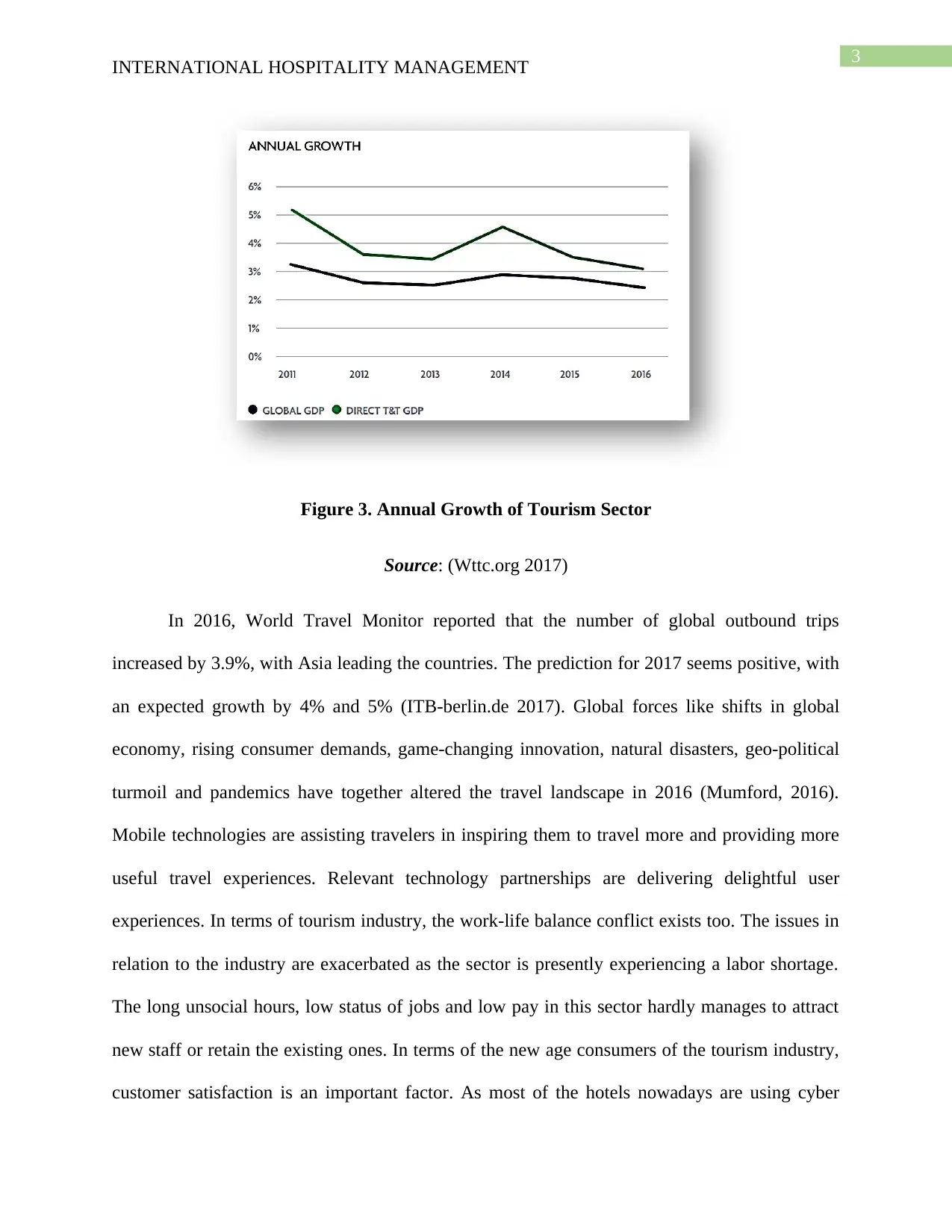
3
INTERNATIONAL HOSPITALITY MANAGEMENT
Figure 3. Annual Growth of Tourism Sector
Source: (Wttc.org 2017)
In 2016, World Travel Monitor reported that the number of global outbound trips
increased by 3.9%, with Asia leading the countries. The prediction for 2017 seems positive, with
an expected growth by 4% and 5% (ITB-berlin.de 2017). Global forces like shifts in global
economy, rising consumer demands, game-changing innovation, natural disasters, geo-political
turmoil and pandemics have together altered the travel landscape in 2016 (Mumford, 2016).
Mobile technologies are assisting travelers in inspiring them to travel more and providing more
useful travel experiences. Relevant technology partnerships are delivering delightful user
experiences. In terms of tourism industry, the work-life balance conflict exists too. The issues in
relation to the industry are exacerbated as the sector is presently experiencing a labor shortage.
The long unsocial hours, low status of jobs and low pay in this sector hardly manages to attract
new staff or retain the existing ones. In terms of the new age consumers of the tourism industry,
customer satisfaction is an important factor. As most of the hotels nowadays are using cyber
INTERNATIONAL HOSPITALITY MANAGEMENT
Figure 3. Annual Growth of Tourism Sector
Source: (Wttc.org 2017)
In 2016, World Travel Monitor reported that the number of global outbound trips
increased by 3.9%, with Asia leading the countries. The prediction for 2017 seems positive, with
an expected growth by 4% and 5% (ITB-berlin.de 2017). Global forces like shifts in global
economy, rising consumer demands, game-changing innovation, natural disasters, geo-political
turmoil and pandemics have together altered the travel landscape in 2016 (Mumford, 2016).
Mobile technologies are assisting travelers in inspiring them to travel more and providing more
useful travel experiences. Relevant technology partnerships are delivering delightful user
experiences. In terms of tourism industry, the work-life balance conflict exists too. The issues in
relation to the industry are exacerbated as the sector is presently experiencing a labor shortage.
The long unsocial hours, low status of jobs and low pay in this sector hardly manages to attract
new staff or retain the existing ones. In terms of the new age consumers of the tourism industry,
customer satisfaction is an important factor. As most of the hotels nowadays are using cyber
Paraphrase This Document
Need a fresh take? Get an instant paraphrase of this document with our AI Paraphraser
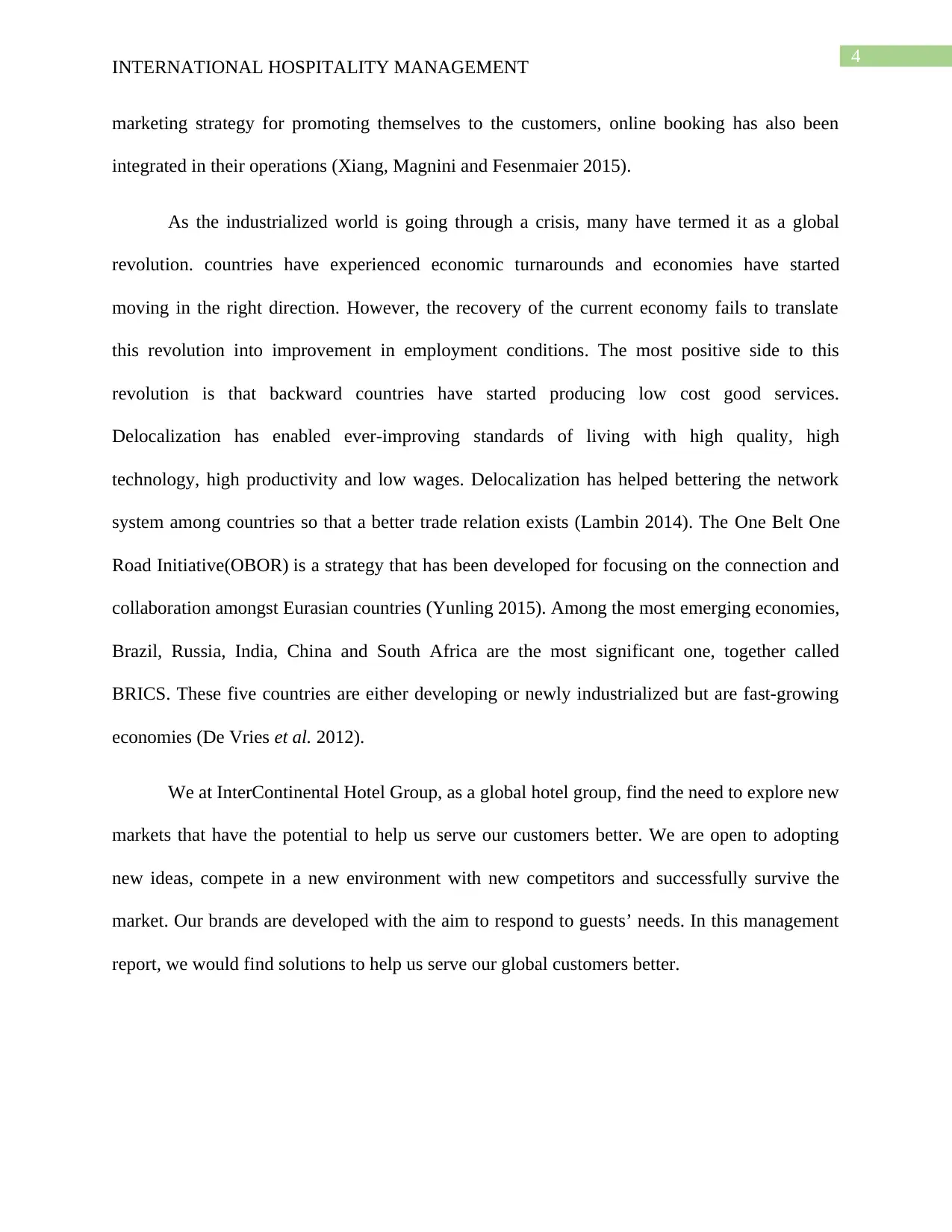
4
INTERNATIONAL HOSPITALITY MANAGEMENT
marketing strategy for promoting themselves to the customers, online booking has also been
integrated in their operations (Xiang, Magnini and Fesenmaier 2015).
As the industrialized world is going through a crisis, many have termed it as a global
revolution. countries have experienced economic turnarounds and economies have started
moving in the right direction. However, the recovery of the current economy fails to translate
this revolution into improvement in employment conditions. The most positive side to this
revolution is that backward countries have started producing low cost good services.
Delocalization has enabled ever-improving standards of living with high quality, high
technology, high productivity and low wages. Delocalization has helped bettering the network
system among countries so that a better trade relation exists (Lambin 2014). The One Belt One
Road Initiative(OBOR) is a strategy that has been developed for focusing on the connection and
collaboration amongst Eurasian countries (Yunling 2015). Among the most emerging economies,
Brazil, Russia, India, China and South Africa are the most significant one, together called
BRICS. These five countries are either developing or newly industrialized but are fast-growing
economies (De Vries et al. 2012).
We at InterContinental Hotel Group, as a global hotel group, find the need to explore new
markets that have the potential to help us serve our customers better. We are open to adopting
new ideas, compete in a new environment with new competitors and successfully survive the
market. Our brands are developed with the aim to respond to guests’ needs. In this management
report, we would find solutions to help us serve our global customers better.
INTERNATIONAL HOSPITALITY MANAGEMENT
marketing strategy for promoting themselves to the customers, online booking has also been
integrated in their operations (Xiang, Magnini and Fesenmaier 2015).
As the industrialized world is going through a crisis, many have termed it as a global
revolution. countries have experienced economic turnarounds and economies have started
moving in the right direction. However, the recovery of the current economy fails to translate
this revolution into improvement in employment conditions. The most positive side to this
revolution is that backward countries have started producing low cost good services.
Delocalization has enabled ever-improving standards of living with high quality, high
technology, high productivity and low wages. Delocalization has helped bettering the network
system among countries so that a better trade relation exists (Lambin 2014). The One Belt One
Road Initiative(OBOR) is a strategy that has been developed for focusing on the connection and
collaboration amongst Eurasian countries (Yunling 2015). Among the most emerging economies,
Brazil, Russia, India, China and South Africa are the most significant one, together called
BRICS. These five countries are either developing or newly industrialized but are fast-growing
economies (De Vries et al. 2012).
We at InterContinental Hotel Group, as a global hotel group, find the need to explore new
markets that have the potential to help us serve our customers better. We are open to adopting
new ideas, compete in a new environment with new competitors and successfully survive the
market. Our brands are developed with the aim to respond to guests’ needs. In this management
report, we would find solutions to help us serve our global customers better.
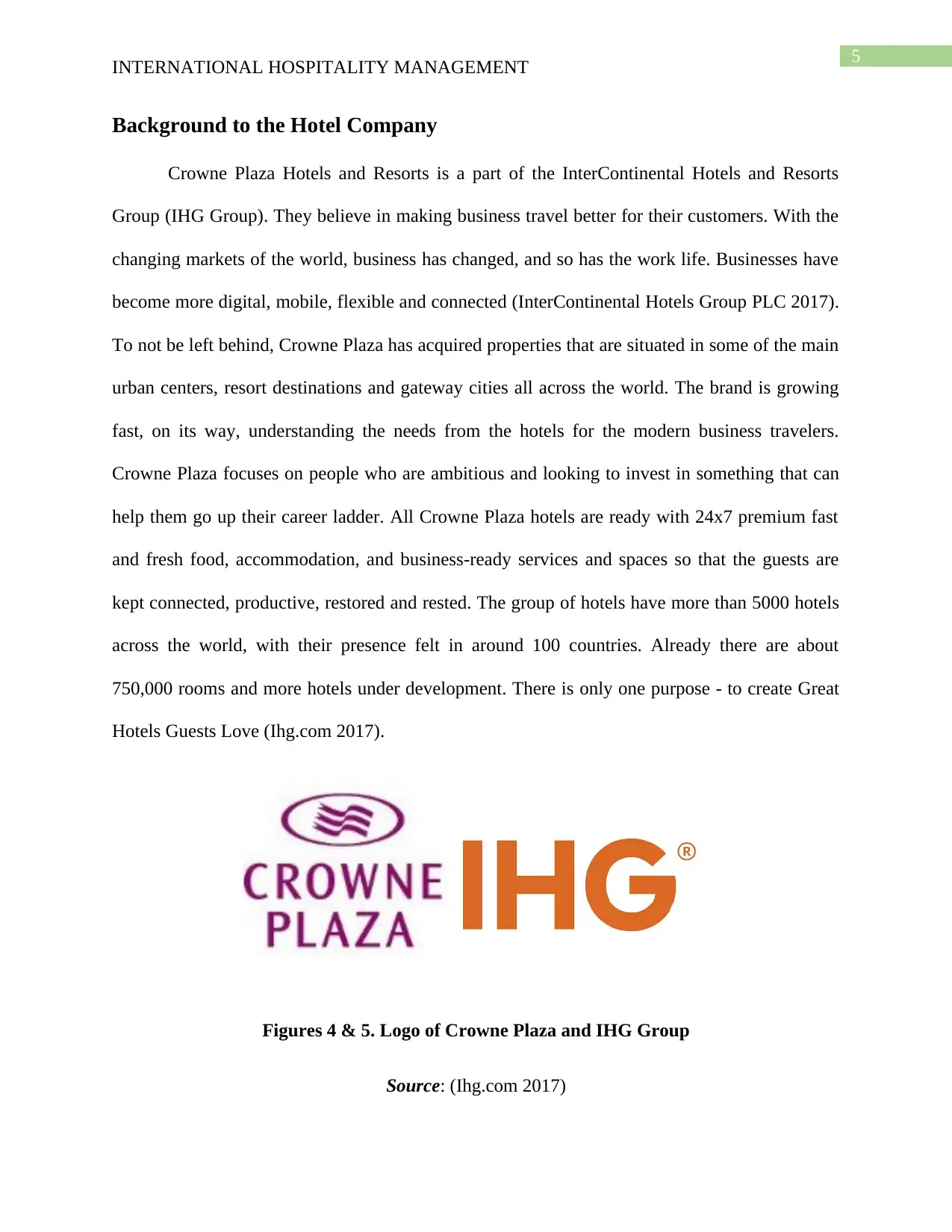
5
INTERNATIONAL HOSPITALITY MANAGEMENT
Background to the Hotel Company
Crowne Plaza Hotels and Resorts is a part of the InterContinental Hotels and Resorts
Group (IHG Group). They believe in making business travel better for their customers. With the
changing markets of the world, business has changed, and so has the work life. Businesses have
become more digital, mobile, flexible and connected (InterContinental Hotels Group PLC 2017).
To not be left behind, Crowne Plaza has acquired properties that are situated in some of the main
urban centers, resort destinations and gateway cities all across the world. The brand is growing
fast, on its way, understanding the needs from the hotels for the modern business travelers.
Crowne Plaza focuses on people who are ambitious and looking to invest in something that can
help them go up their career ladder. All Crowne Plaza hotels are ready with 24x7 premium fast
and fresh food, accommodation, and business-ready services and spaces so that the guests are
kept connected, productive, restored and rested. The group of hotels have more than 5000 hotels
across the world, with their presence felt in around 100 countries. Already there are about
750,000 rooms and more hotels under development. There is only one purpose - to create Great
Hotels Guests Love (Ihg.com 2017).
Figures 4 & 5. Logo of Crowne Plaza and IHG Group
Source: (Ihg.com 2017)
INTERNATIONAL HOSPITALITY MANAGEMENT
Background to the Hotel Company
Crowne Plaza Hotels and Resorts is a part of the InterContinental Hotels and Resorts
Group (IHG Group). They believe in making business travel better for their customers. With the
changing markets of the world, business has changed, and so has the work life. Businesses have
become more digital, mobile, flexible and connected (InterContinental Hotels Group PLC 2017).
To not be left behind, Crowne Plaza has acquired properties that are situated in some of the main
urban centers, resort destinations and gateway cities all across the world. The brand is growing
fast, on its way, understanding the needs from the hotels for the modern business travelers.
Crowne Plaza focuses on people who are ambitious and looking to invest in something that can
help them go up their career ladder. All Crowne Plaza hotels are ready with 24x7 premium fast
and fresh food, accommodation, and business-ready services and spaces so that the guests are
kept connected, productive, restored and rested. The group of hotels have more than 5000 hotels
across the world, with their presence felt in around 100 countries. Already there are about
750,000 rooms and more hotels under development. There is only one purpose - to create Great
Hotels Guests Love (Ihg.com 2017).
Figures 4 & 5. Logo of Crowne Plaza and IHG Group
Source: (Ihg.com 2017)
⊘ This is a preview!⊘
Do you want full access?
Subscribe today to unlock all pages.

Trusted by 1+ million students worldwide
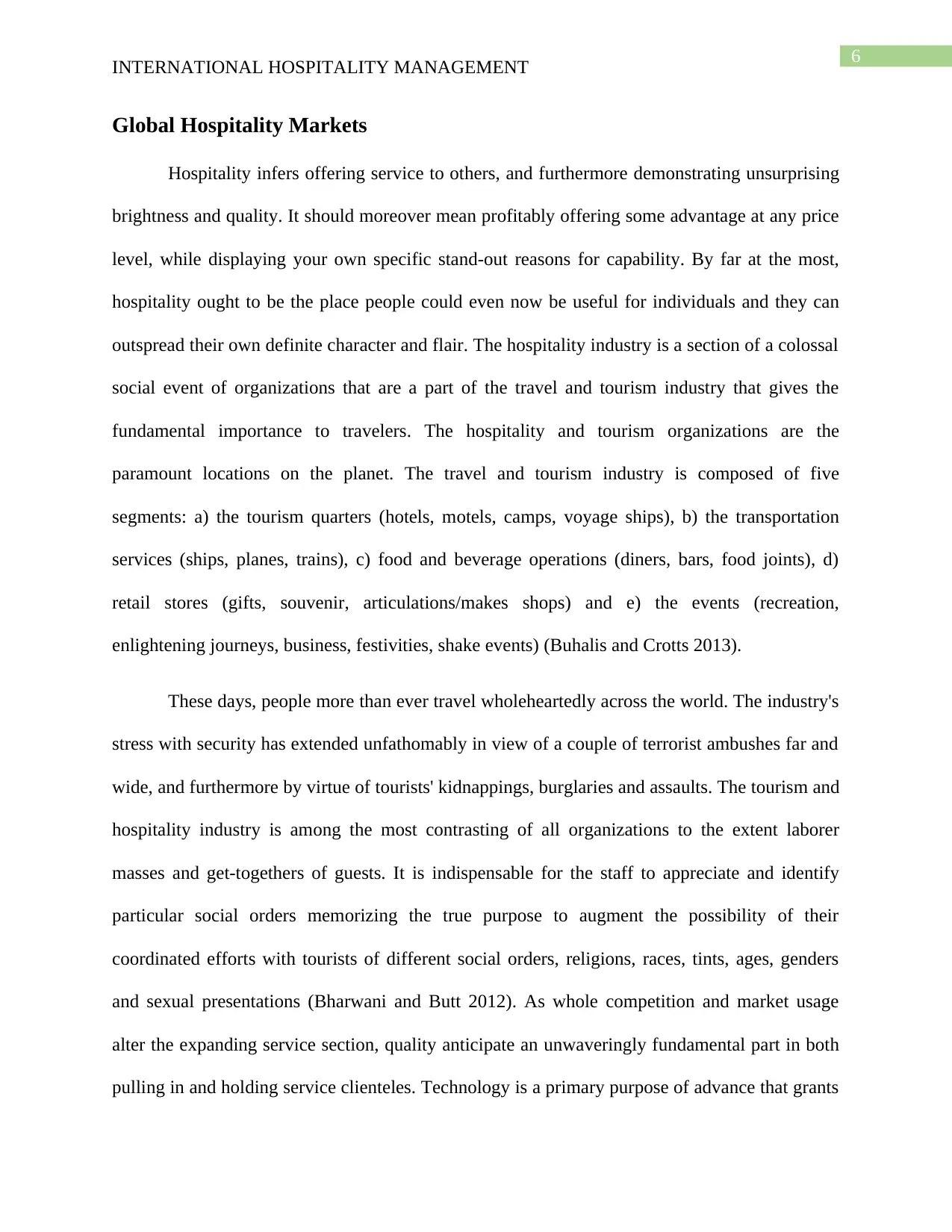
6
INTERNATIONAL HOSPITALITY MANAGEMENT
Global Hospitality Markets
Hospitality infers offering service to others, and furthermore demonstrating unsurprising
brightness and quality. It should moreover mean profitably offering some advantage at any price
level, while displaying your own specific stand-out reasons for capability. By far at the most,
hospitality ought to be the place people could even now be useful for individuals and they can
outspread their own definite character and flair. The hospitality industry is a section of a colossal
social event of organizations that are a part of the travel and tourism industry that gives the
fundamental importance to travelers. The hospitality and tourism organizations are the
paramount locations on the planet. The travel and tourism industry is composed of five
segments: a) the tourism quarters (hotels, motels, camps, voyage ships), b) the transportation
services (ships, planes, trains), c) food and beverage operations (diners, bars, food joints), d)
retail stores (gifts, souvenir, articulations/makes shops) and e) the events (recreation,
enlightening journeys, business, festivities, shake events) (Buhalis and Crotts 2013).
These days, people more than ever travel wholeheartedly across the world. The industry's
stress with security has extended unfathomably in view of a couple of terrorist ambushes far and
wide, and furthermore by virtue of tourists' kidnappings, burglaries and assaults. The tourism and
hospitality industry is among the most contrasting of all organizations to the extent laborer
masses and get-togethers of guests. It is indispensable for the staff to appreciate and identify
particular social orders memorizing the true purpose to augment the possibility of their
coordinated efforts with tourists of different social orders, religions, races, tints, ages, genders
and sexual presentations (Bharwani and Butt 2012). As whole competition and market usage
alter the expanding service section, quality anticipate an unwaveringly fundamental part in both
pulling in and holding service clienteles. Technology is a primary purpose of advance that grants
INTERNATIONAL HOSPITALITY MANAGEMENT
Global Hospitality Markets
Hospitality infers offering service to others, and furthermore demonstrating unsurprising
brightness and quality. It should moreover mean profitably offering some advantage at any price
level, while displaying your own specific stand-out reasons for capability. By far at the most,
hospitality ought to be the place people could even now be useful for individuals and they can
outspread their own definite character and flair. The hospitality industry is a section of a colossal
social event of organizations that are a part of the travel and tourism industry that gives the
fundamental importance to travelers. The hospitality and tourism organizations are the
paramount locations on the planet. The travel and tourism industry is composed of five
segments: a) the tourism quarters (hotels, motels, camps, voyage ships), b) the transportation
services (ships, planes, trains), c) food and beverage operations (diners, bars, food joints), d)
retail stores (gifts, souvenir, articulations/makes shops) and e) the events (recreation,
enlightening journeys, business, festivities, shake events) (Buhalis and Crotts 2013).
These days, people more than ever travel wholeheartedly across the world. The industry's
stress with security has extended unfathomably in view of a couple of terrorist ambushes far and
wide, and furthermore by virtue of tourists' kidnappings, burglaries and assaults. The tourism and
hospitality industry is among the most contrasting of all organizations to the extent laborer
masses and get-togethers of guests. It is indispensable for the staff to appreciate and identify
particular social orders memorizing the true purpose to augment the possibility of their
coordinated efforts with tourists of different social orders, religions, races, tints, ages, genders
and sexual presentations (Bharwani and Butt 2012). As whole competition and market usage
alter the expanding service section, quality anticipate an unwaveringly fundamental part in both
pulling in and holding service clienteles. Technology is a primary purpose of advance that grants
Paraphrase This Document
Need a fresh take? Get an instant paraphrase of this document with our AI Paraphraser
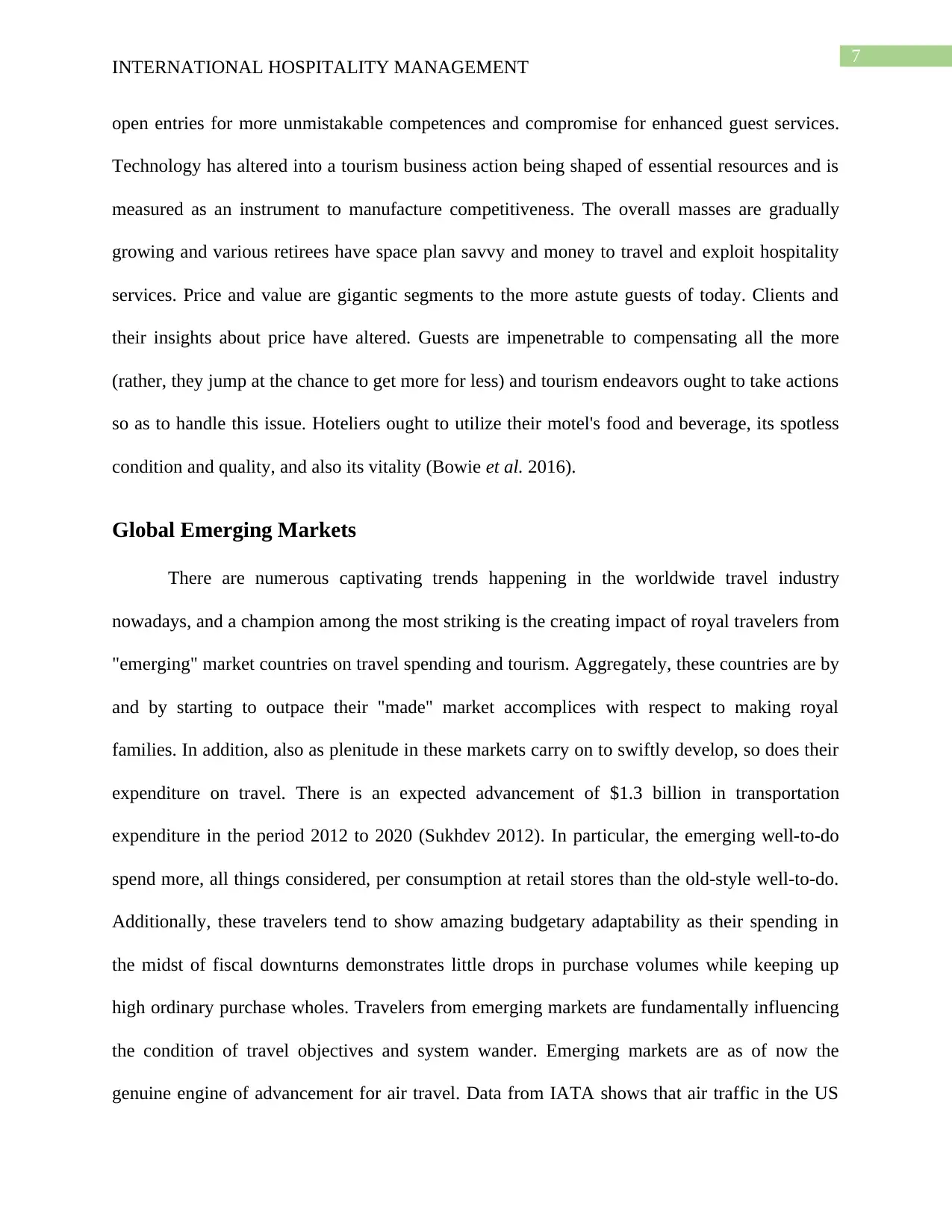
7
INTERNATIONAL HOSPITALITY MANAGEMENT
open entries for more unmistakable competences and compromise for enhanced guest services.
Technology has altered into a tourism business action being shaped of essential resources and is
measured as an instrument to manufacture competitiveness. The overall masses are gradually
growing and various retirees have space plan savvy and money to travel and exploit hospitality
services. Price and value are gigantic segments to the more astute guests of today. Clients and
their insights about price have altered. Guests are impenetrable to compensating all the more
(rather, they jump at the chance to get more for less) and tourism endeavors ought to take actions
so as to handle this issue. Hoteliers ought to utilize their motel's food and beverage, its spotless
condition and quality, and also its vitality (Bowie et al. 2016).
Global Emerging Markets
There are numerous captivating trends happening in the worldwide travel industry
nowadays, and a champion among the most striking is the creating impact of royal travelers from
"emerging" market countries on travel spending and tourism. Aggregately, these countries are by
and by starting to outpace their "made" market accomplices with respect to making royal
families. In addition, also as plenitude in these markets carry on to swiftly develop, so does their
expenditure on travel. There is an expected advancement of $1.3 billion in transportation
expenditure in the period 2012 to 2020 (Sukhdev 2012). In particular, the emerging well-to-do
spend more, all things considered, per consumption at retail stores than the old-style well-to-do.
Additionally, these travelers tend to show amazing budgetary adaptability as their spending in
the midst of fiscal downturns demonstrates little drops in purchase volumes while keeping up
high ordinary purchase wholes. Travelers from emerging markets are fundamentally influencing
the condition of travel objectives and system wander. Emerging markets are as of now the
genuine engine of advancement for air travel. Data from IATA shows that air traffic in the US
INTERNATIONAL HOSPITALITY MANAGEMENT
open entries for more unmistakable competences and compromise for enhanced guest services.
Technology has altered into a tourism business action being shaped of essential resources and is
measured as an instrument to manufacture competitiveness. The overall masses are gradually
growing and various retirees have space plan savvy and money to travel and exploit hospitality
services. Price and value are gigantic segments to the more astute guests of today. Clients and
their insights about price have altered. Guests are impenetrable to compensating all the more
(rather, they jump at the chance to get more for less) and tourism endeavors ought to take actions
so as to handle this issue. Hoteliers ought to utilize their motel's food and beverage, its spotless
condition and quality, and also its vitality (Bowie et al. 2016).
Global Emerging Markets
There are numerous captivating trends happening in the worldwide travel industry
nowadays, and a champion among the most striking is the creating impact of royal travelers from
"emerging" market countries on travel spending and tourism. Aggregately, these countries are by
and by starting to outpace their "made" market accomplices with respect to making royal
families. In addition, also as plenitude in these markets carry on to swiftly develop, so does their
expenditure on travel. There is an expected advancement of $1.3 billion in transportation
expenditure in the period 2012 to 2020 (Sukhdev 2012). In particular, the emerging well-to-do
spend more, all things considered, per consumption at retail stores than the old-style well-to-do.
Additionally, these travelers tend to show amazing budgetary adaptability as their spending in
the midst of fiscal downturns demonstrates little drops in purchase volumes while keeping up
high ordinary purchase wholes. Travelers from emerging markets are fundamentally influencing
the condition of travel objectives and system wander. Emerging markets are as of now the
genuine engine of advancement for air travel. Data from IATA shows that air traffic in the US
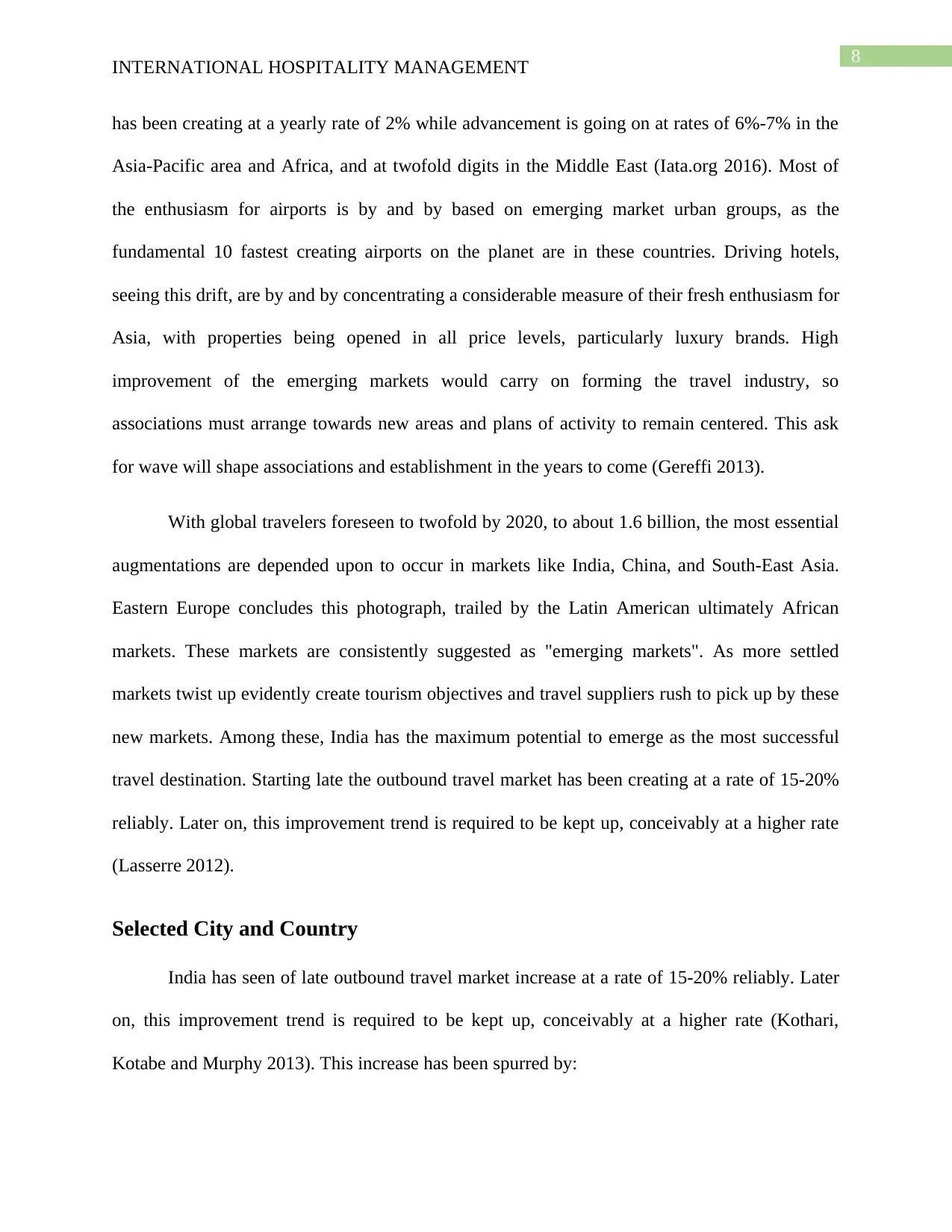
8
INTERNATIONAL HOSPITALITY MANAGEMENT
has been creating at a yearly rate of 2% while advancement is going on at rates of 6%-7% in the
Asia-Pacific area and Africa, and at twofold digits in the Middle East (Iata.org 2016). Most of
the enthusiasm for airports is by and by based on emerging market urban groups, as the
fundamental 10 fastest creating airports on the planet are in these countries. Driving hotels,
seeing this drift, are by and by concentrating a considerable measure of their fresh enthusiasm for
Asia, with properties being opened in all price levels, particularly luxury brands. High
improvement of the emerging markets would carry on forming the travel industry, so
associations must arrange towards new areas and plans of activity to remain centered. This ask
for wave will shape associations and establishment in the years to come (Gereffi 2013).
With global travelers foreseen to twofold by 2020, to about 1.6 billion, the most essential
augmentations are depended upon to occur in markets like India, China, and South-East Asia.
Eastern Europe concludes this photograph, trailed by the Latin American ultimately African
markets. These markets are consistently suggested as "emerging markets". As more settled
markets twist up evidently create tourism objectives and travel suppliers rush to pick up by these
new markets. Among these, India has the maximum potential to emerge as the most successful
travel destination. Starting late the outbound travel market has been creating at a rate of 15-20%
reliably. Later on, this improvement trend is required to be kept up, conceivably at a higher rate
(Lasserre 2012).
Selected City and Country
India has seen of late outbound travel market increase at a rate of 15-20% reliably. Later
on, this improvement trend is required to be kept up, conceivably at a higher rate (Kothari,
Kotabe and Murphy 2013). This increase has been spurred by:
INTERNATIONAL HOSPITALITY MANAGEMENT
has been creating at a yearly rate of 2% while advancement is going on at rates of 6%-7% in the
Asia-Pacific area and Africa, and at twofold digits in the Middle East (Iata.org 2016). Most of
the enthusiasm for airports is by and by based on emerging market urban groups, as the
fundamental 10 fastest creating airports on the planet are in these countries. Driving hotels,
seeing this drift, are by and by concentrating a considerable measure of their fresh enthusiasm for
Asia, with properties being opened in all price levels, particularly luxury brands. High
improvement of the emerging markets would carry on forming the travel industry, so
associations must arrange towards new areas and plans of activity to remain centered. This ask
for wave will shape associations and establishment in the years to come (Gereffi 2013).
With global travelers foreseen to twofold by 2020, to about 1.6 billion, the most essential
augmentations are depended upon to occur in markets like India, China, and South-East Asia.
Eastern Europe concludes this photograph, trailed by the Latin American ultimately African
markets. These markets are consistently suggested as "emerging markets". As more settled
markets twist up evidently create tourism objectives and travel suppliers rush to pick up by these
new markets. Among these, India has the maximum potential to emerge as the most successful
travel destination. Starting late the outbound travel market has been creating at a rate of 15-20%
reliably. Later on, this improvement trend is required to be kept up, conceivably at a higher rate
(Lasserre 2012).
Selected City and Country
India has seen of late outbound travel market increase at a rate of 15-20% reliably. Later
on, this improvement trend is required to be kept up, conceivably at a higher rate (Kothari,
Kotabe and Murphy 2013). This increase has been spurred by:
⊘ This is a preview!⊘
Do you want full access?
Subscribe today to unlock all pages.

Trusted by 1+ million students worldwide
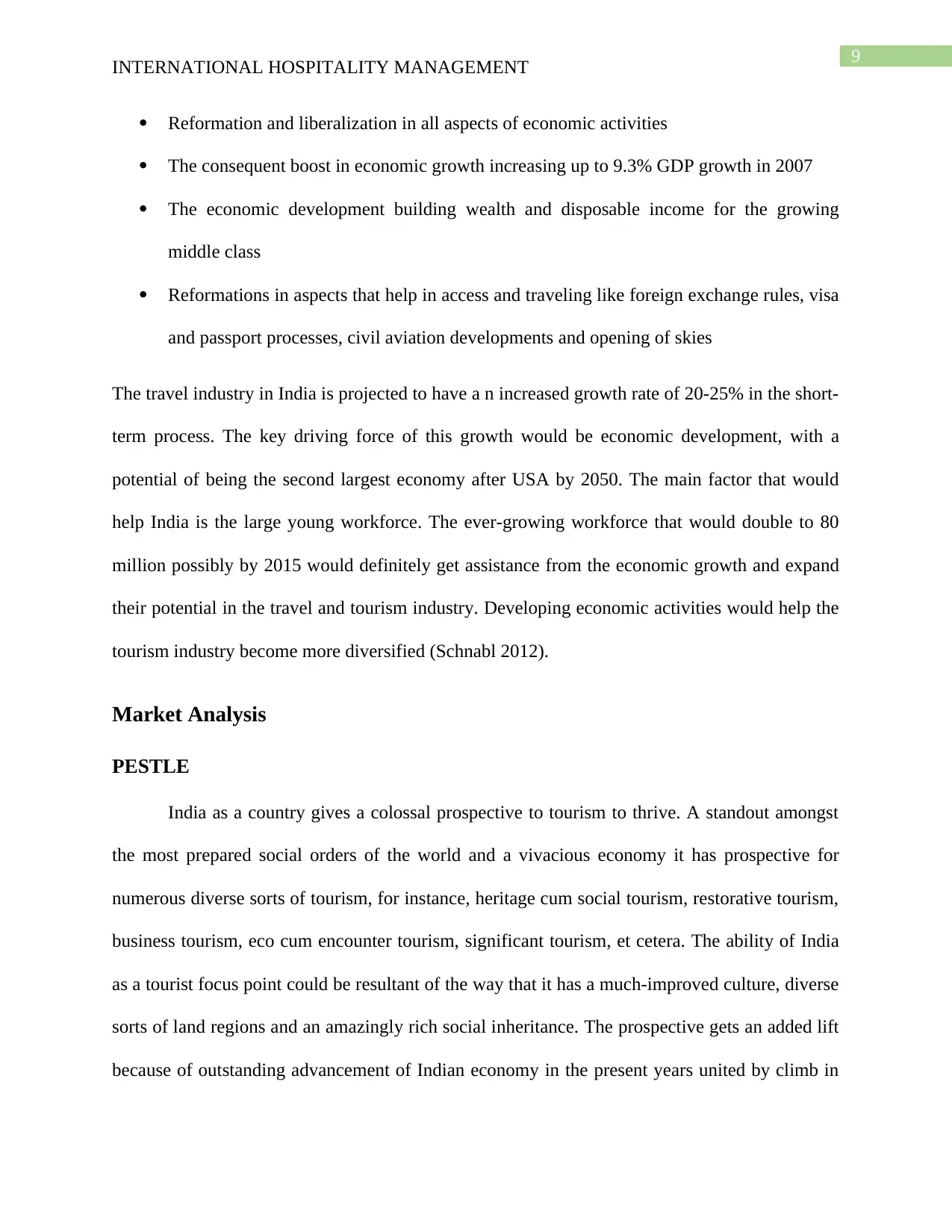
9
INTERNATIONAL HOSPITALITY MANAGEMENT
Reformation and liberalization in all aspects of economic activities
The consequent boost in economic growth increasing up to 9.3% GDP growth in 2007
The economic development building wealth and disposable income for the growing
middle class
Reformations in aspects that help in access and traveling like foreign exchange rules, visa
and passport processes, civil aviation developments and opening of skies
The travel industry in India is projected to have a n increased growth rate of 20-25% in the short-
term process. The key driving force of this growth would be economic development, with a
potential of being the second largest economy after USA by 2050. The main factor that would
help India is the large young workforce. The ever-growing workforce that would double to 80
million possibly by 2015 would definitely get assistance from the economic growth and expand
their potential in the travel and tourism industry. Developing economic activities would help the
tourism industry become more diversified (Schnabl 2012).
Market Analysis
PESTLE
India as a country gives a colossal prospective to tourism to thrive. A standout amongst
the most prepared social orders of the world and a vivacious economy it has prospective for
numerous diverse sorts of tourism, for instance, heritage cum social tourism, restorative tourism,
business tourism, eco cum encounter tourism, significant tourism, et cetera. The ability of India
as a tourist focus point could be resultant of the way that it has a much-improved culture, diverse
sorts of land regions and an amazingly rich social inheritance. The prospective gets an added lift
because of outstanding advancement of Indian economy in the present years united by climb in
INTERNATIONAL HOSPITALITY MANAGEMENT
Reformation and liberalization in all aspects of economic activities
The consequent boost in economic growth increasing up to 9.3% GDP growth in 2007
The economic development building wealth and disposable income for the growing
middle class
Reformations in aspects that help in access and traveling like foreign exchange rules, visa
and passport processes, civil aviation developments and opening of skies
The travel industry in India is projected to have a n increased growth rate of 20-25% in the short-
term process. The key driving force of this growth would be economic development, with a
potential of being the second largest economy after USA by 2050. The main factor that would
help India is the large young workforce. The ever-growing workforce that would double to 80
million possibly by 2015 would definitely get assistance from the economic growth and expand
their potential in the travel and tourism industry. Developing economic activities would help the
tourism industry become more diversified (Schnabl 2012).
Market Analysis
PESTLE
India as a country gives a colossal prospective to tourism to thrive. A standout amongst
the most prepared social orders of the world and a vivacious economy it has prospective for
numerous diverse sorts of tourism, for instance, heritage cum social tourism, restorative tourism,
business tourism, eco cum encounter tourism, significant tourism, et cetera. The ability of India
as a tourist focus point could be resultant of the way that it has a much-improved culture, diverse
sorts of land regions and an amazingly rich social inheritance. The prospective gets an added lift
because of outstanding advancement of Indian economy in the present years united by climb in
Paraphrase This Document
Need a fresh take? Get an instant paraphrase of this document with our AI Paraphraser
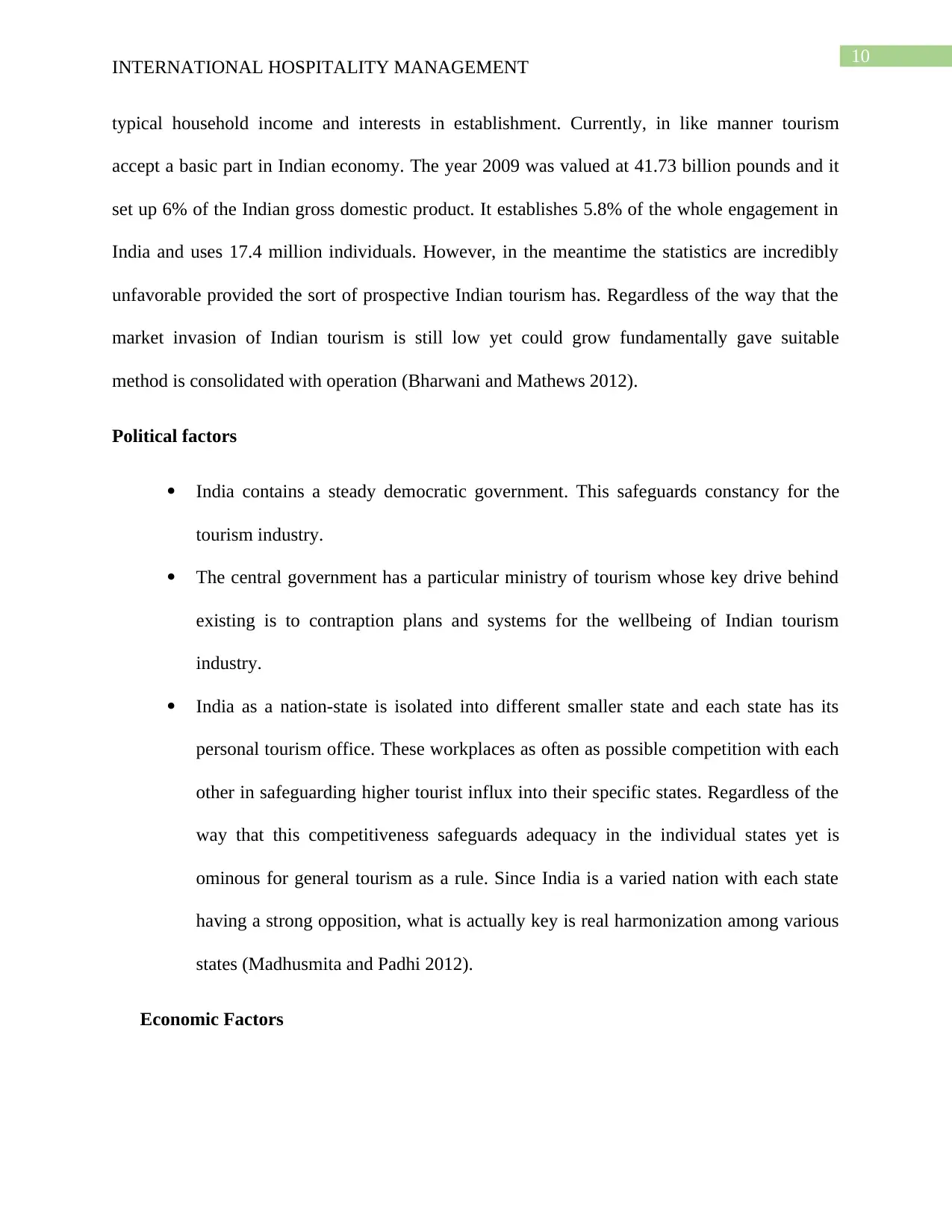
10
INTERNATIONAL HOSPITALITY MANAGEMENT
typical household income and interests in establishment. Currently, in like manner tourism
accept a basic part in Indian economy. The year 2009 was valued at 41.73 billion pounds and it
set up 6% of the Indian gross domestic product. It establishes 5.8% of the whole engagement in
India and uses 17.4 million individuals. However, in the meantime the statistics are incredibly
unfavorable provided the sort of prospective Indian tourism has. Regardless of the way that the
market invasion of Indian tourism is still low yet could grow fundamentally gave suitable
method is consolidated with operation (Bharwani and Mathews 2012).
Political factors
India contains a steady democratic government. This safeguards constancy for the
tourism industry.
The central government has a particular ministry of tourism whose key drive behind
existing is to contraption plans and systems for the wellbeing of Indian tourism
industry.
India as a nation-state is isolated into different smaller state and each state has its
personal tourism office. These workplaces as often as possible competition with each
other in safeguarding higher tourist influx into their specific states. Regardless of the
way that this competitiveness safeguards adequacy in the individual states yet is
ominous for general tourism as a rule. Since India is a varied nation with each state
having a strong opposition, what is actually key is real harmonization among various
states (Madhusmita and Padhi 2012).
Economic Factors
INTERNATIONAL HOSPITALITY MANAGEMENT
typical household income and interests in establishment. Currently, in like manner tourism
accept a basic part in Indian economy. The year 2009 was valued at 41.73 billion pounds and it
set up 6% of the Indian gross domestic product. It establishes 5.8% of the whole engagement in
India and uses 17.4 million individuals. However, in the meantime the statistics are incredibly
unfavorable provided the sort of prospective Indian tourism has. Regardless of the way that the
market invasion of Indian tourism is still low yet could grow fundamentally gave suitable
method is consolidated with operation (Bharwani and Mathews 2012).
Political factors
India contains a steady democratic government. This safeguards constancy for the
tourism industry.
The central government has a particular ministry of tourism whose key drive behind
existing is to contraption plans and systems for the wellbeing of Indian tourism
industry.
India as a nation-state is isolated into different smaller state and each state has its
personal tourism office. These workplaces as often as possible competition with each
other in safeguarding higher tourist influx into their specific states. Regardless of the
way that this competitiveness safeguards adequacy in the individual states yet is
ominous for general tourism as a rule. Since India is a varied nation with each state
having a strong opposition, what is actually key is real harmonization among various
states (Madhusmita and Padhi 2012).
Economic Factors
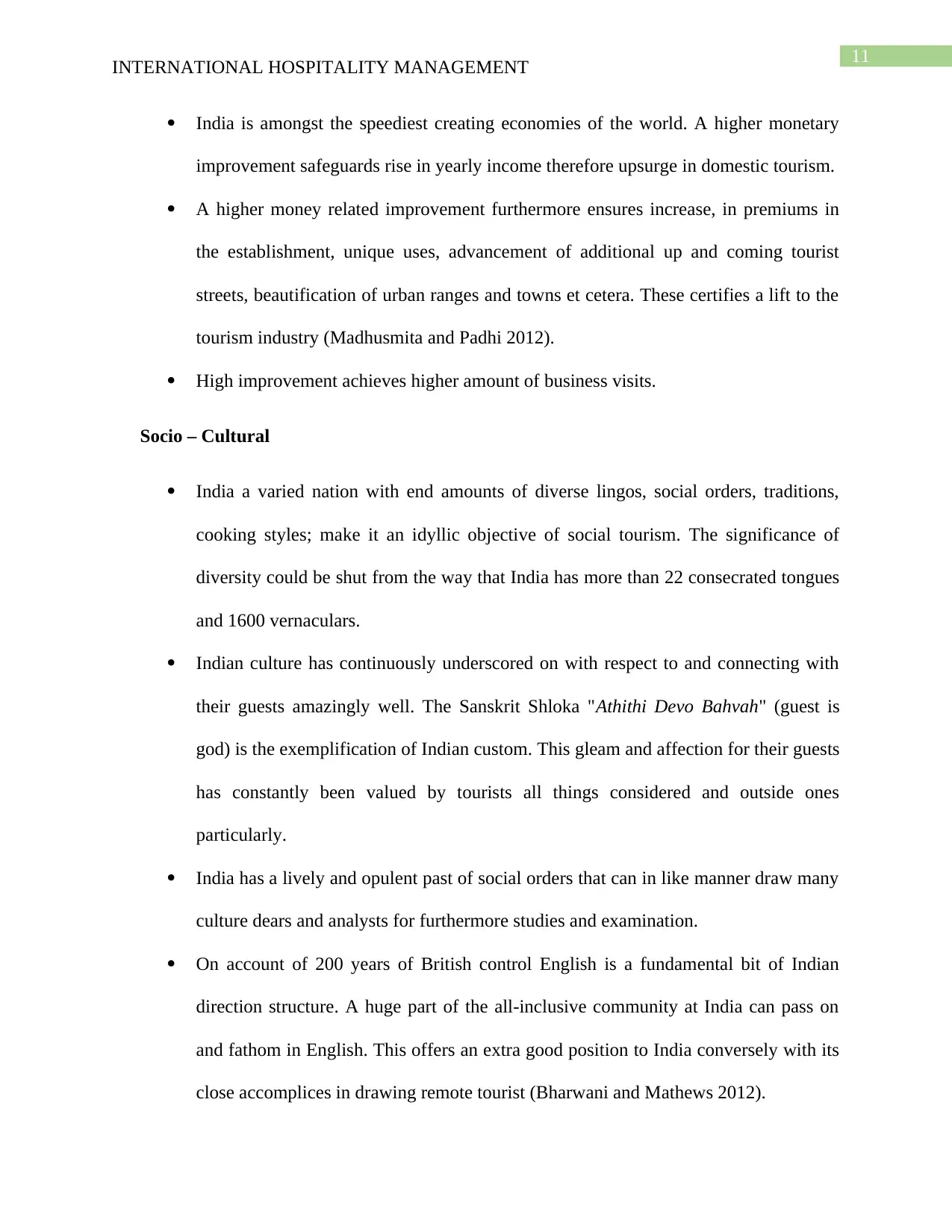
11
INTERNATIONAL HOSPITALITY MANAGEMENT
India is amongst the speediest creating economies of the world. A higher monetary
improvement safeguards rise in yearly income therefore upsurge in domestic tourism.
A higher money related improvement furthermore ensures increase, in premiums in
the establishment, unique uses, advancement of additional up and coming tourist
streets, beautification of urban ranges and towns et cetera. These certifies a lift to the
tourism industry (Madhusmita and Padhi 2012).
High improvement achieves higher amount of business visits.
Socio – Cultural
India a varied nation with end amounts of diverse lingos, social orders, traditions,
cooking styles; make it an idyllic objective of social tourism. The significance of
diversity could be shut from the way that India has more than 22 consecrated tongues
and 1600 vernaculars.
Indian culture has continuously underscored on with respect to and connecting with
their guests amazingly well. The Sanskrit Shloka "Athithi Devo Bahvah" (guest is
god) is the exemplification of Indian custom. This gleam and affection for their guests
has constantly been valued by tourists all things considered and outside ones
particularly.
India has a lively and opulent past of social orders that can in like manner draw many
culture dears and analysts for furthermore studies and examination.
On account of 200 years of British control English is a fundamental bit of Indian
direction structure. A huge part of the all-inclusive community at India can pass on
and fathom in English. This offers an extra good position to India conversely with its
close accomplices in drawing remote tourist (Bharwani and Mathews 2012).
INTERNATIONAL HOSPITALITY MANAGEMENT
India is amongst the speediest creating economies of the world. A higher monetary
improvement safeguards rise in yearly income therefore upsurge in domestic tourism.
A higher money related improvement furthermore ensures increase, in premiums in
the establishment, unique uses, advancement of additional up and coming tourist
streets, beautification of urban ranges and towns et cetera. These certifies a lift to the
tourism industry (Madhusmita and Padhi 2012).
High improvement achieves higher amount of business visits.
Socio – Cultural
India a varied nation with end amounts of diverse lingos, social orders, traditions,
cooking styles; make it an idyllic objective of social tourism. The significance of
diversity could be shut from the way that India has more than 22 consecrated tongues
and 1600 vernaculars.
Indian culture has continuously underscored on with respect to and connecting with
their guests amazingly well. The Sanskrit Shloka "Athithi Devo Bahvah" (guest is
god) is the exemplification of Indian custom. This gleam and affection for their guests
has constantly been valued by tourists all things considered and outside ones
particularly.
India has a lively and opulent past of social orders that can in like manner draw many
culture dears and analysts for furthermore studies and examination.
On account of 200 years of British control English is a fundamental bit of Indian
direction structure. A huge part of the all-inclusive community at India can pass on
and fathom in English. This offers an extra good position to India conversely with its
close accomplices in drawing remote tourist (Bharwani and Mathews 2012).
⊘ This is a preview!⊘
Do you want full access?
Subscribe today to unlock all pages.

Trusted by 1+ million students worldwide
1 out of 25
Related Documents
Your All-in-One AI-Powered Toolkit for Academic Success.
+13062052269
info@desklib.com
Available 24*7 on WhatsApp / Email
![[object Object]](/_next/static/media/star-bottom.7253800d.svg)
Unlock your academic potential
Copyright © 2020–2025 A2Z Services. All Rights Reserved. Developed and managed by ZUCOL.





